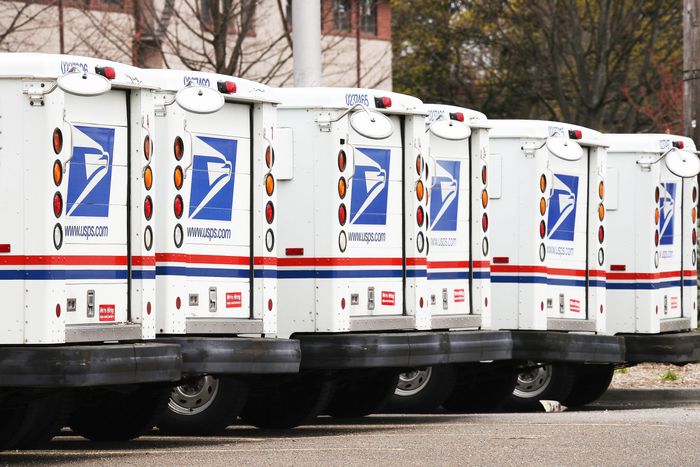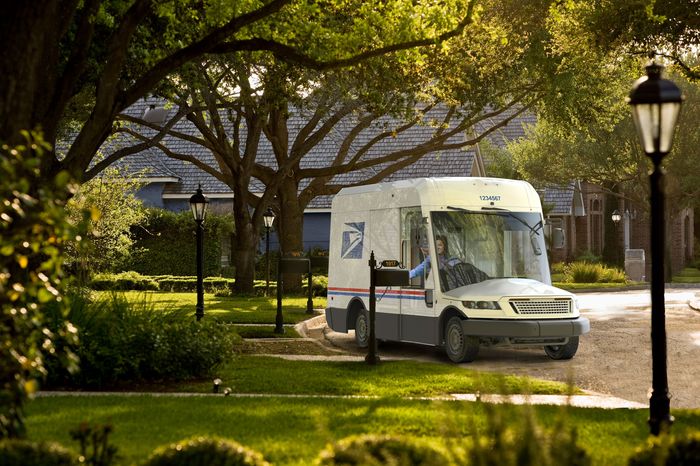
Remember that adorable new U.S. Postal Service truck that the entire internet fainted over? The one that was designed specifically to protect the safety of other road users? The one that was praised because the federal government was overturning decades of bad policy in the name of public health? Turns out that the USPS is planning for most of its so-called next-generation vehicles to run on last generation’s fuel, skirting Joe Biden’s electrification order without quite flouting it.
When the truck design was revealed, one of the major selling points touted by Oshkosh, the defense contractor that won the bid, was that it could be manufactured with either an internal-combustion engine or an electric motor. Additionally, the Postal Service said, a gasoline model could be converted into an EV, so if (let’s say) a particular carrier’s route lacks EV chargers, the truck could start out with a conventional engine and go electric later. But USPS documents say that of the initial 165,000-vehicle procurement, 90 percent will have internal-combustion engines, all but locking in at least a decade of pollution and emissions. And now USPS is no longer proposing the possibility of switching from gas to electric powertrain. Postal vehicles, it should be noted, make up nearly one-third of the entire federal vehicle fleet.
According to a USPS spokesperson, the 10 percent EV investment is “a floor — not a ceiling — based on our current financial condition and the resources we believe we will have available to invest.” This financial condition will be more precarious if the $6 billion for the Postal Service that was promised by the Build Back Better proposal does not materialize. USPS claims that full electrification is the eventual goal: “As part of our commitment to environmental stewardship, the Postal Service is working towards the electrification of our delivery fleet while remaining mindful of our financial and infrastructure constraints and the urgent need to replace our delivery vehicles.”
Those vehicles are the most straightforward electrification candidates today, for both financial and infrastructural reasons, which is why companies like Amazon, FedEx, and UPS are going all-in on electric. Vehicles that deliver mail travel extremely predictable, often low-speed routes — in the USPS, the average is 20 miles per day — that don’t stray very far from where they’re parked at night (in lots the postal service already owns), making it easy to install chargers. Although they cost a little more to buy than gas-driven trucks, they’re much cheaper to run — and gasoline most likely isn’t getting any cheaper in the next couple of decades — so they will save money. The estimated price tag to completely electrify the fleet is $3.3 billion, which seems … worth it? If the argument from the federal government is that investing in charging systems is too expensive, what hope does this country have for any fleet, from National Park Service jeeps to big-city articulated buses, to go electric?
Since the new postal vehicle was announced last year, legislators have tried to coax USPS to raise the proportion to, at least, 75 percent EVs. In a heavily footnoted letter, the EPA publicly questioned the data and calculations set forth in USPS’s own environmental analysis, calling the plan a “lost opportunity to more rapidly reduce the carbon footprint of one of the largest government fleets in the world.” But remember that postmaster general is Louis De Joy — who could flip the ratio himself — appointed during the Trump administration, is still calling the shots. Which is why a group of advocates, including Earthjustice, the Union of Concerned Scientists, NRDC, and the Sierra Club, is appealing directly to Biden by encouraging a little-known procedure that allows the White House Council on Environmental Quality to settle interagency disputes.
Last year, Biden signed an executive order requiring that all light-duty vehicles acquired by the federal government will be 100 percent electric by 2027. The federal fleet is 645,000 vehicles, about 225,000 of which belong to the Postal Service. So even if, hypothetically, the gasoline-burning trucks from this first procurement were the last of them (which they likely won’t be), that all but locks in a quarter of the federal fleet to fossil fuels for another 20 years (or more: The last of USPS’s current “long life vehicles” were made in 1994, and, true to their name, they’re still on roads). That doesn’t really align with Biden’s vision, especially if there’s an option to invest in an electric future now. And it certainly doesn’t fit with the vehicle’s forward-looking design, which may save some lives by preventing fatal crashes only to leave all the rest of us choking on smog.





